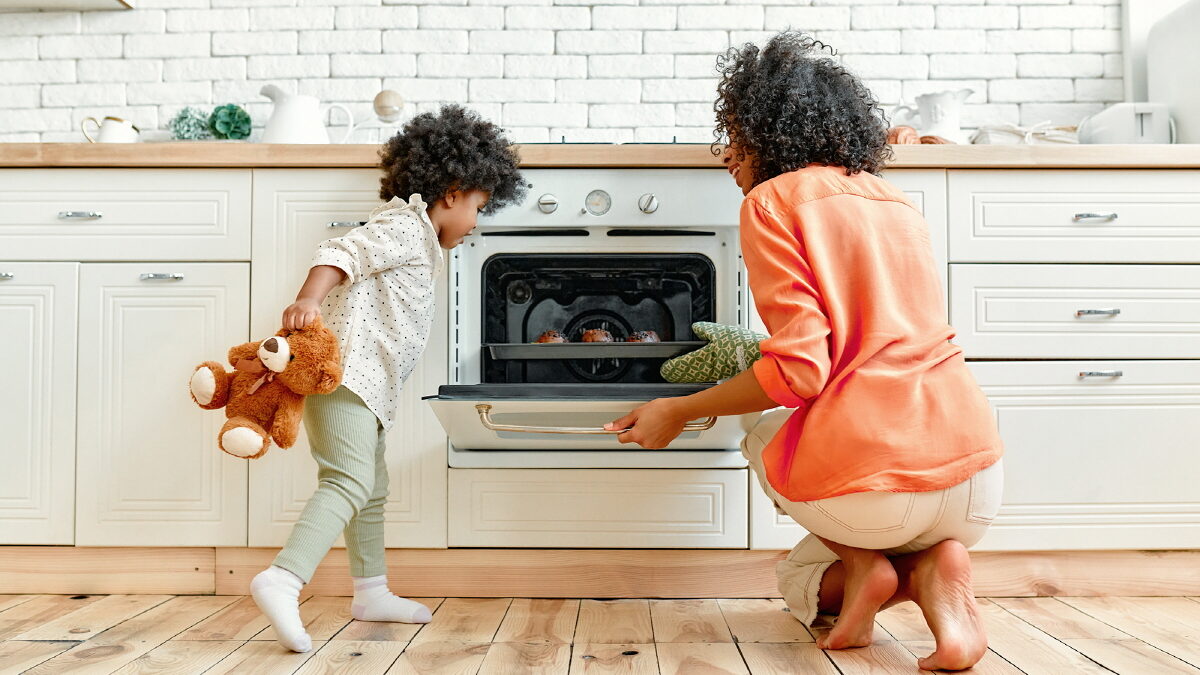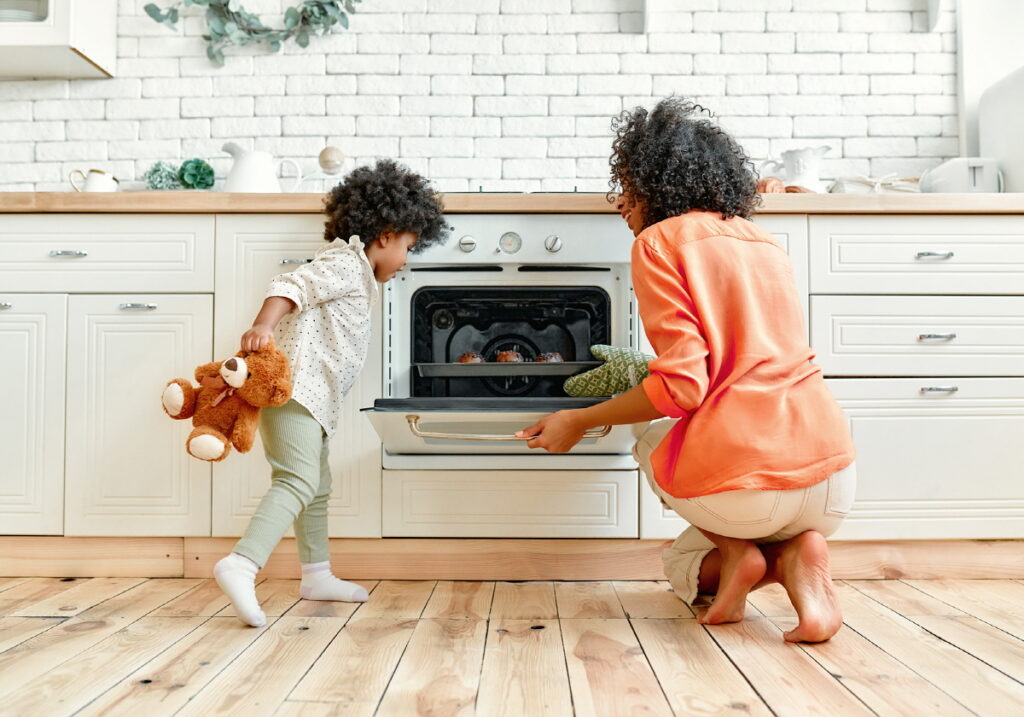
With innovations around materials and manufacturing, vinyl and laminate flooring have become top choices for kitchen flooring. Both flooring materials are durable, affordable, customizable, and offer vast selections of styles and colors. However, there are differences. If you want to replace your kitchen floor, vinyl and laminate may be on your list of options, but which is best? This guide will help you decide which flooring material is best for your lifestyle and design goals by comparing specific features, including cost, durability, installation methods, water and heat resistance, design and appearance, and more.
Vinyl Flooring for Kitchens
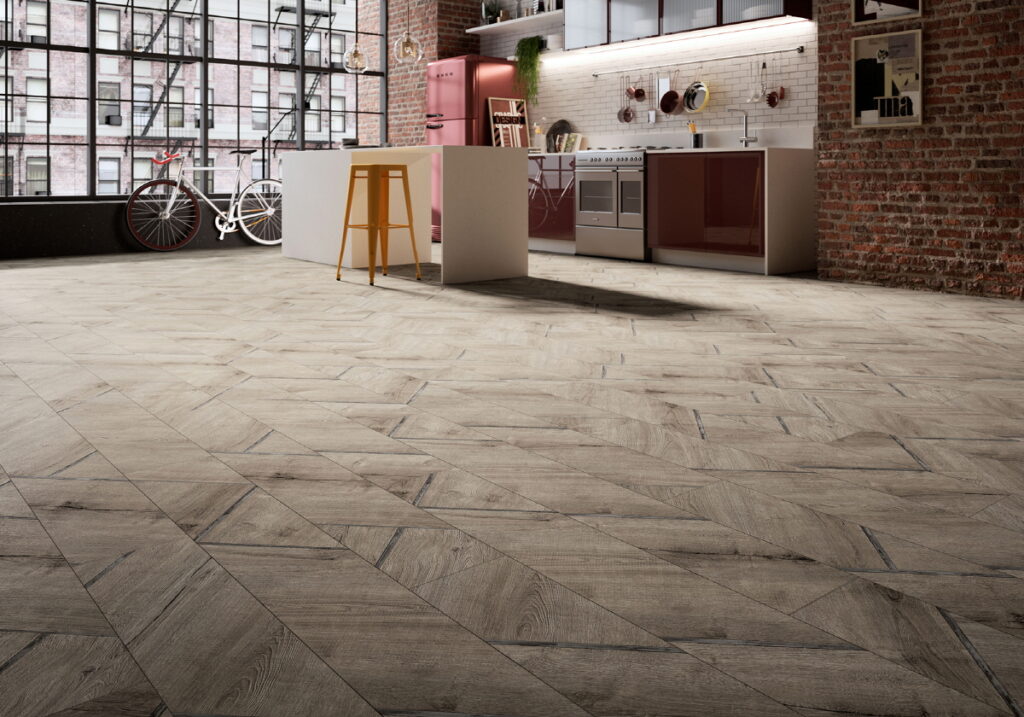
Vinyl flooring consists of layers of materials and polymers that create durable flooring. The backing—or bottom layers—is made of cork or foam and acts as the underlayment, eliminating the need for another material during installation. This cork or foam layer also provides a cushion to make the floor more comfortable and a sound barrier to reduce noise. The flooring’s top wear layer is transparent, covering and protecting the image layer below it. The thickest middle layer consists of a dense plastic core, providing structure, stability, and enhancing performance.
Installation
Luxury vinyl tile is thicker than standard vinyl and comes in both tile and plank formats. Luxury vinyl tile (LVT) can help you achieve the look of a natural stone floor, while luxury vinyl plank (LVP) is an ideal alternative to natural wood flooring. Most experienced do-it-yourselfers can easily snap together and install LVT and LVP. To install, start from the most visible end of the room and snap each tile into place. When necessary, use a sharp utility knife to cut the planks to fit along the wall or to create notches.
Water and Heat Resistance
Vinyl flooring is an excellent choice for a kitchen as it is highly waterproof. When exposed to water, even large amounts of water or moisture, it can be dried without losing shape or appearance. While most LVT and LVP are resistant to flames and will not contribute to the spread of fire, they are susceptible to damage from high temperatures, so exercise caution with hot items such as oil, dishes, and pans to prevent any damage to the floor.
Cleanliness and Maintenance
Vinyl flooring is easy to maintain. Water and a soft cloth will clean up spills. Mopping once a week with a vinegar and water mixture or a vinyl floor cleaner keeps your floors glowing. Use a baking soda and water paste for stuck-on food stains or dirt buildup. For things like paint or crayons, use rubbing alcohol, and for scuffs, WD-40 rubbed on with a towel will get the mark out. Keeping the floor dust and dirt free is key, so sweeping daily and putting doormats by exterior entrances will help. With regular cleaning, vinyl floors will look beautiful for years.
Cost
Sheet vinyl flooring can be as low as $0.50 to $2.00 per square foot, while plank and tile vinyl generally range from $0.60 to $4.00, though some high-quality vinyl products may exceed this. The cost of installation offsets the economical pricing. A skilled do-it-yourselfer can lay plank or tile vinyl, but a professional installation is required for sheet vinyl.
Appearance and Design
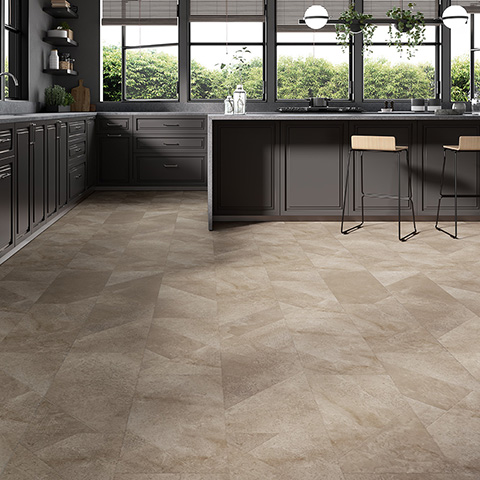
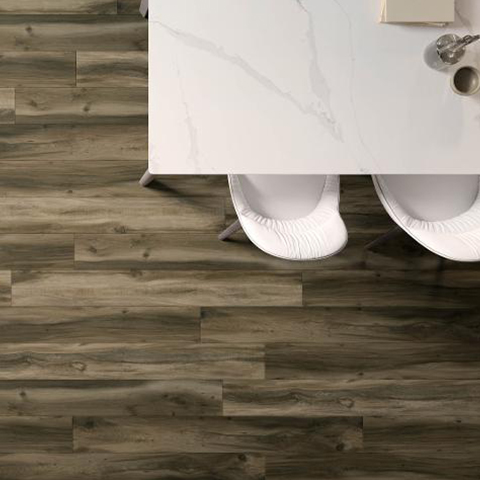
H·FLOR VINTAGE from Savana Collection
Vinyl’s image layer can mimic the look of real stone or wood with an endless variety of options in color, texture, wood grain, etc. The latest forms of LVT are remarkable and look and feel like stone or wood.
Durability
Vinyl flooring is known for being durable, which means that most LVT is water-resistant and low maintenance. With its wear layer, a vinyl floor will typically not stain and can endure lots of wear and tear. It’s a good option for any highly trafficked areas like kitchens.
Size
Luxury vinyl flooring typically comes in either plank or tile form. Standard plank sizes are 48 inches by 6 inches or 48 inches by 4 1/2 inches. The regular tile size is 16 x 16 inches, though smaller and larger sizes are also available.
Laminate Flooring for Kitchen
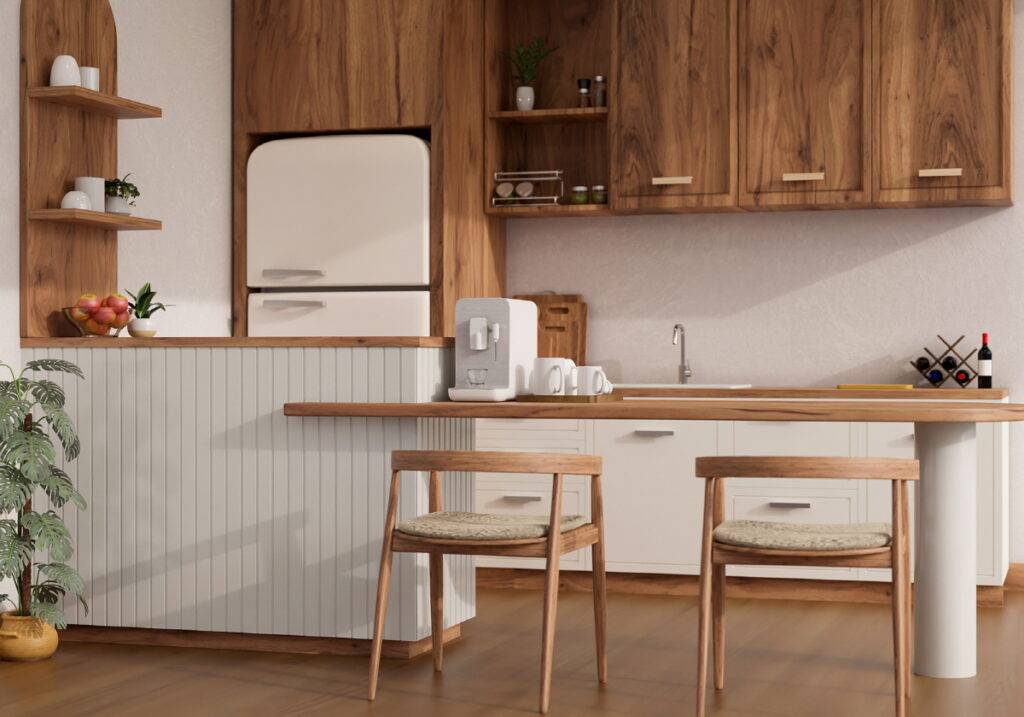
Laminate flooring allows you to get the look of wood or tile for less. It’s constructed of high-density wood fiberboard and is created to be durable. Laminate consists of up to five layers sealed together through a lamination process. The decor—or second layer—includes a printed image that can imitate the look of more expensive flooring, like stone or wood. A thin, impact-resistant layer covers the high-density fiberboard, making up the product’s bulk. To create a softer cushion, the bottom layer is either a soft foam or paper.
Installation
Laminate flooring is somewhat easy to install with its snap-and-click process, making the installation perfect for the typical DIYer. However, it requires precise measurements, the right tools, and proper technique. If you are new to home renovation projects or do not have the necessary tools, consider hiring a professional contractor. They will have all the essential materials and tools, plus the experience and know-how to complete the job.
Water and Heat Resistance
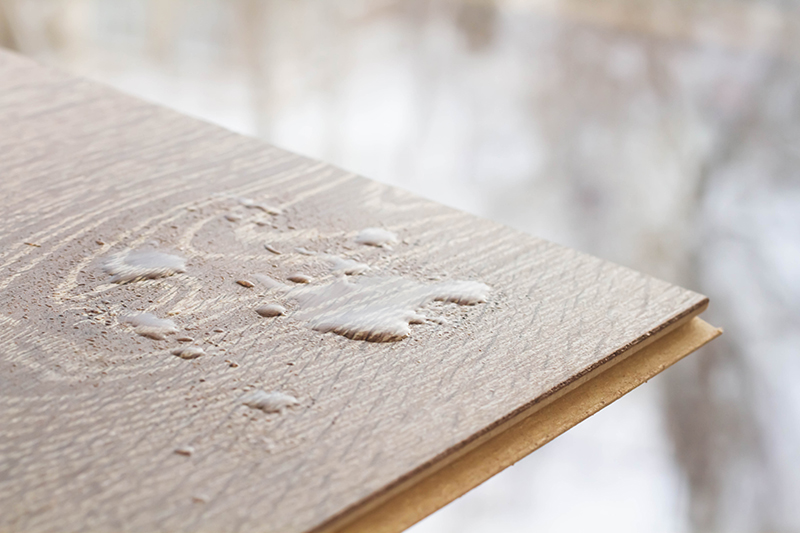
Laminate flooring is not water resistant. Excess water caused by careless cleaning or spills can cause the laminate to warp or stain, especially near seams or edges. If liquid gets in, the wood fiberboard core will soak it up and distort, and it will not return to its original shape. The high-density fiberboard core is largely impervious to heat. However, because the top layer is plastic, it may melt under extreme heat—although those high temperatures are rarely reached in your kitchen.
Cleanliness and Maintenance
To avoid expensive repairs or having to do replacements, it’s vital to clean laminate floors with care. To avoid stains, wipe up spills immediately. Don’t use abrasive cleaners on your laminate flooring, as it can scratch easily. Use a soft bristle broom for daily cleanup. Laminate floors can be mopped with either a damp microfiber mop or a regular mop wrung almost dry. It’s important not to use too much water and only use cleaning products designed for laminate.
Cost
Laminate flooring comes in a wide range of styles and prices. Discount stores may charge as little as $0.50 and up to $3.00 per square foot, and name-brand laminate usually costs between $3.00 and $8.00 per square foot. Unless your warranty calls for a professional installation, most laminate flooring can be installed by a DIYer. But if you decide to hire a professional, don’t forget to include those costs in your budget.
Appearance and Design
Most varieties of laminate flooring are intended to mimic the look of rustic antique hardwood, distinctive wood stains, or exotic wood species. It can also be constructed to look like stone or tile flooring.
Durability
Laminate flooring is durable; however, liquids can damage it, so it is critical to minimize exposure to them. Laminate can withstand a lot of traffic and doesn’t scratch or discolor as easily as hardwood floors.
Size
Most laminate flooring ranges between 5″ and 8″ planks but may be cut to look like 3″ or 2″ board patterns. For smaller areas, use 3″ -5″ wide planks to help open up the space, while 6″ -8″ planks will make larger rooms look more warm and attractive.
Contact Us
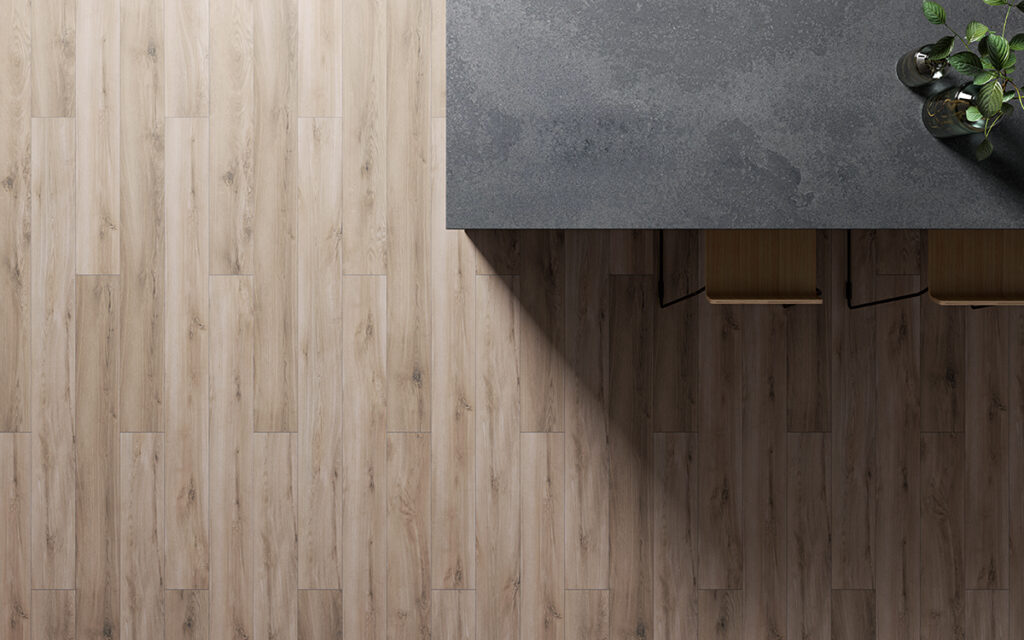
LX Hausys has various high-quality, easy-to-install vinyl flooring products. Any of our flooring experts would be happy to help you with your kitchen flooring needs and designs. Please use the form on our website so we can connect you with the appropriate team member, who will respond to you quickly.

